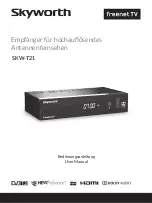
To receive broadcast signals, your terrestrial indoor or outdoor antenna must be connected to the
ANT IN connector on the back of the receiver. Use a proper shielded antenna cable and suitable
connectors.
NOTE:
If the signals at your location are too weak to receive proper signals with
an indoor antenna, we recommend using an outdoor antenna which
can be pointed towards the transmission tower. Ask your local dealer for
more information. If you are using an active antenna with built-in antenna
amplifier, switch the antenna power to
ON
in the menu
Manual Search
.
3.2 Connecting to TV with HDMI cable
Fig. 6
The TV set shall be connected to the receiver using a good quality HDMI cable. This connection gives
the highest possible picture quality.
3.3 Connecting to TV with SCART cable
Fig. 6
Your receiver is also equipped with a SCART connector; alternatively, the TV set can be connected to
the receiver using a good quality SCART cable.
3.4 Connecting a USB storage device
Fig. 6
This port can be used for USB storage devices such as USB pen drives or HDD with a maximum peak
current of 800 mA. It is recommended to use USB 2.0 storage devices (or higher) for playback of video
files or HD movies.
3.5 Connecting to Ethernet for RSS feeds and weather
forecasts
Fig. 7
To use this option of your receiver it must be connected to your router. Connect the Ethernet (RJ-45)
connector with a class CAT5E (or higher) cable to your router.
3.6 Extended connections for your home entertainment
Fig. 8.
Connecting to a Digital Audio Amplifier with S/PDIF
By connecting your receiver to a digital amplifier or home cinema set, you can enjoy the best possible
sound quality and multi-channel audio (depending on broadcast). Connect your Digital Audio
Amplifier or home cinema set with a suitable cinch cable to the S/PDIF connector on the back of the
receiver. Alternatively, if you’re using an analogue amplifier, then connect the audio output jack for
stereo audio.
8













































